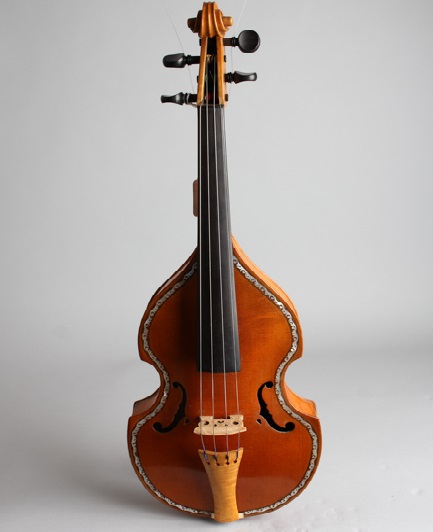Philomel
Bowed Instruments
Europe
Between 1001 and 1900 AD
Video
The Philomel, a unique musical instrument, has a rich history and a significant place in both music and mythology. Named after the mythological figure Philomela, who was transformed into a nightingale, the instrument carries with it the essence of song and lamentation. In this blog post, we will delve into what the Philomel is, its origins, how it works, its various types, features, the kind of music composed with it, and its cultural significance.
The Philomel is a string instrument that resembles a violin but is distinct in its construction and sound. It typically features four steel-wire strings and is played with a bow. The design of the Philomel allows for a bright and resonant tone that can evoke a range of emotions. While it may not be as widely recognized as other string instruments like the violin or cello, the Philomel holds a special place in certain musical traditions and compositions.
History of the Philomel
The history of the Philomel is intertwined with mythology and cultural evolution. Originating in Europe, specifically in France during the 17th century, the instrument was developed as part of a broader trend towards creating string instruments that could produce richer sounds suitable for both solo performances and ensemble settings. The name “Philomel” itself is derived from Greek mythology, where Philomela was a figure associated with song and tragedy. In Ovid’s “Metamorphoses,” Philomela’s transformation into a nightingale symbolizes her enduring voice despite her suffering. The connection between the instrument and its mythological namesake highlights how art often reflects cultural narratives. The nightingale’s song has been celebrated throughout history as one of beauty and sorrow, which resonates with the emotional depth that musicians seek to convey through their performances on the Philomel.
How It Works
The working mechanism of the Philomel is similar to that of other bowed string instruments. It consists of four strings that are stretched over a wooden body. When played with a bow, the strings vibrate to produce sound. The tension and thickness of the strings contribute to the overall timbre and pitch range of the instrument. Musicians can manipulate their playing technique to achieve various dynamics and articulations. The use of steel-wire strings allows for greater projection and clarity in sound compared to gut strings traditionally used in other string instruments. This characteristic makes the Philomel particularly appealing for both soloists and ensemble players who wish to stand out in their performances.
Types of Philomels
There are several variations of the Philomel, each adapted for different musical contexts:
- Standard Philomel: This version features four strings and is primarily used in classical music settings.
- Philomel with Frets: Some models include frets similar to those found on guitars or lutes, allowing for easier finger placement and intonation.
- Electric Philomel: A modern adaptation that incorporates electronic amplification, enabling musicians to explore new soundscapes.
- Philomel Variants: Various folk traditions may have their interpretations or adaptations of the Philomel, reflecting local musical styles.
Each type serves different purposes within musical genres ranging from classical to folk music.
Features
The features of the Philomel contribute significantly to its unique sound:
Construction: Typically made from high-quality wood such as maple or spruce, which enhances resonance.
Strings: Four steel-wire strings that provide bright tones and sustain.
Bow: A specially designed bow that complements the instrument’s construction.
Size: Generally smaller than violins, allowing for easier handling by musicians.
These features allow musicians to explore a wide range of musical expressions while maintaining traditional playing techniques.
Kind of Music Composed
The music composed for the Philomel spans various genres but is predominantly rooted in classical compositions. Many contemporary composers have drawn inspiration from its unique sound quality to create new works that highlight its capabilities. Additionally, folk music traditions incorporate the Philomel into their repertoires, often using it to accompany dances or vocal performances. Notable compositions include Milton Babbitt’s “Philomel,” which combines live voice with synthesized sounds, exploring themes from Ovid’s myth while showcasing the instrument’s versatility. This piece exemplifies how modern composers continue to engage with historical instruments while pushing musical boundaries.
Significance
The significance of the Philomel extends beyond its musical capabilities; it embodies cultural narratives that resonate through time. As an instrument associated with song and lamentation, it serves as a reminder of human experiences—joys intertwined with sorrows. In educational contexts, learning to play the Philomel offers students insight into historical music practices while developing their technical skills on string instruments. Furthermore, its presence in contemporary compositions bridges traditional music with modern artistic expressions. The revival of interest in historical instruments like the Philomel reflects broader trends in musicology where musicians seek authenticity by reconnecting with traditions. Festivals celebrating folk music often feature performances on this instrument, fostering community engagement and appreciation for cultural heritage.
The Philomel stands as a testament to human creativity and resilience through music. Its history rooted in mythology enriches its narrative while inviting musicians to explore new realms of expression. As we continue to celebrate diverse musical traditions worldwide, instruments like the Philomel remind us of our shared humanity through song.
FAQ
What material is the Philomel instrument made of?
The Philomel is often crafted from high-quality woods like maple or spruce, with fine strings made of gut or metal, and intricate inlays or decorations.
What type of music is commonly played on a Philomel?
The Philomel is typically used for light classical and folk music, often serving as a solo or accompanying instrument due to its sweet, melodic sound.
What kind of instrument is a Philomel?
The Philomel is a string instrument resembling a violin but with a unique timbre, often played with a bow and known for its delicate resonance.
 Links
Links
References
Other Instrument
Categories


















